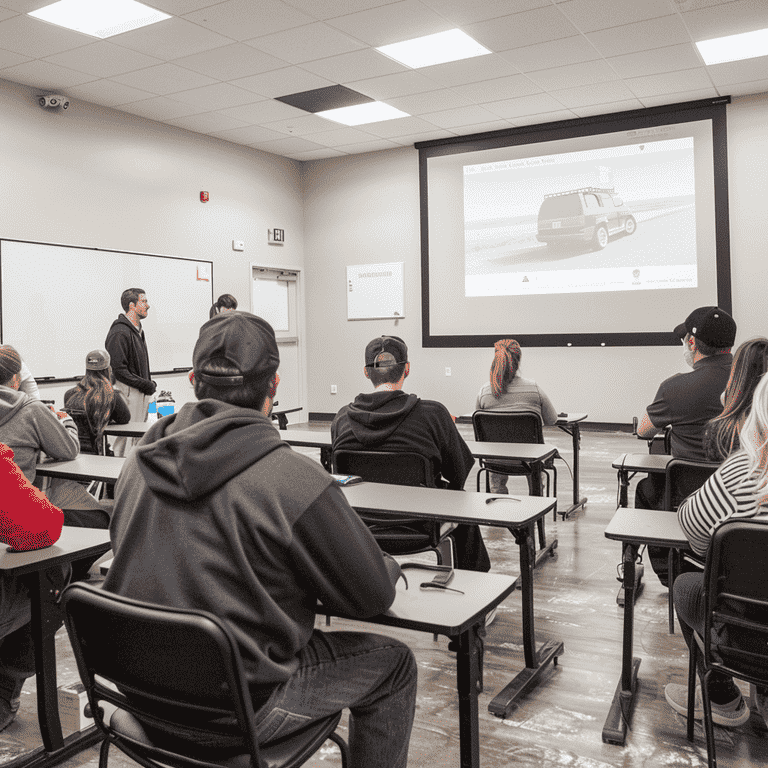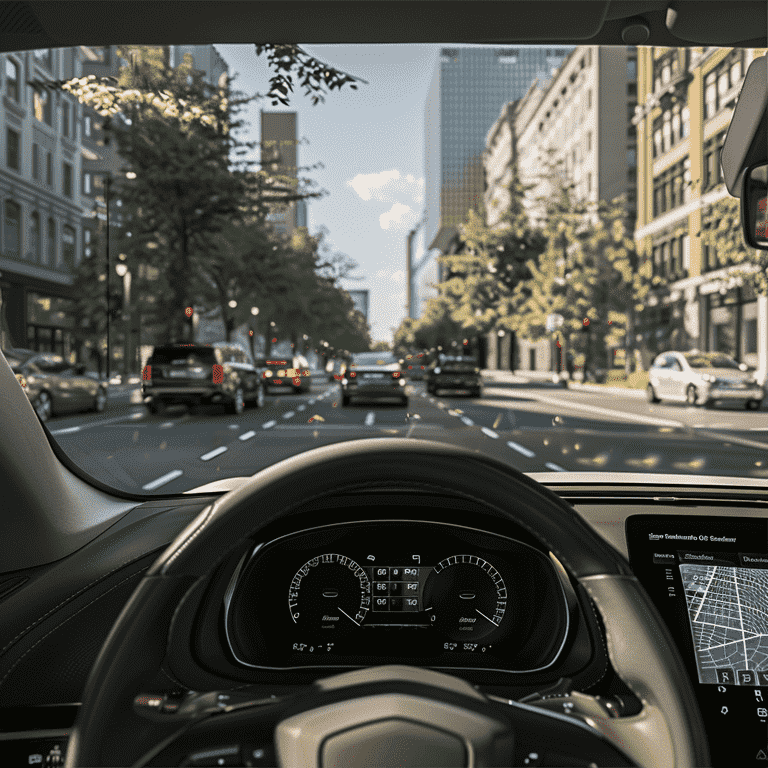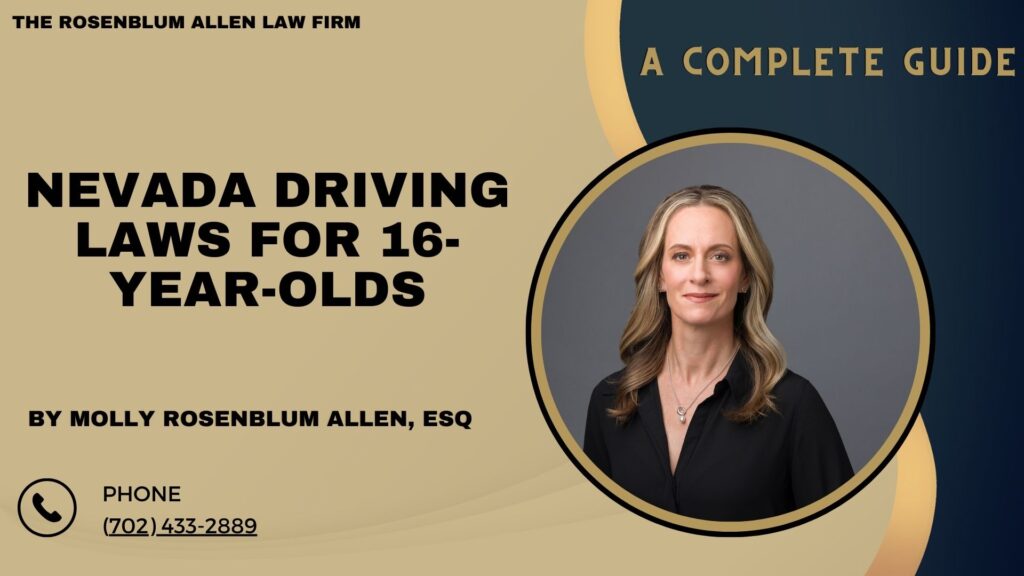If you or your teenager is getting ready to hit the road in Nevada, it’s crucial to understand the driving laws for 16-year-olds. These rules aim to keep young drivers safe while they gain experience behind the wheel. Understanding these laws can help you avoid unnecessary fines, penalties, or worse—an accident. Let’s explore what you need to know about getting a driver’s license in Nevada if you’re 16.
Eligibility Requirements for 16-Year-Old Drivers in Nevada
Age Requirements
To start driving in Nevada, the minimum age to apply for a learner’s permit is 15½ years old. However, most teenagers begin the process at 16. This is the age when many are fully eligible to meet all requirements for obtaining a permit and eventually a driver’s license.
Residency Requirements
To apply for a driving permit or license, you must be a resident of Nevada. Residency can be proven with several types of documentation, including:
- A utility bill with your name and address
- A rental or lease agreement
- A school transcript showing your Nevada address
- A parent or guardian’s Nevada driver’s license with the same address
It’s important to have these documents ready before heading to the DMV.
Educational Requirements
If you’re under 18, you must be enrolled in school to apply for a learner’s permit or driver’s license in Nevada. The state requires that you be attending school regularly and making satisfactory progress. If you’re not in school, you’ll need to provide proof of an equivalent education, like a GED.
You’ll also need to complete a driver’s education course. This course is mandatory and must be taken from an approved provider. The course covers essential topics like traffic laws, safe driving practices, and the consequences of reckless driving.
The Nevada Learner’s Permit for 16-Year-Olds
How to Apply for a Learner’s Permit
Applying for a learner’s permit in Nevada is straightforward but requires some preparation. Here’s what you’ll need:
- Proof of Identity: Birth certificate, U.S. passport, or other official documents.
- Social Security Number: You’ll need to provide your Social Security card.
- Residency Proof: As mentioned earlier, documents like a utility bill or school transcript.
- Parent or Guardian Consent: If you’re under 18, a parent or guardian must sign your application.
- Application Fee: The fee varies, so check the DMV website for current rates.
Once you have these documents, visit your local DMV office to fill out the application. Afterward, you’ll take a vision test and a written knowledge exam. Passing both allows you to receive your learner’s permit.
Learner’s Permit Restrictions
With a learner’s permit in hand, you can start driving, but there are important restrictions:
- Supervised Driving Only: You must have a licensed driver, aged 21 or older, in the front passenger seat at all times while driving.
- No Driving at Night: Typically, you cannot drive between 10 p.m. and 5 a.m. unless you’re driving to or from work or a school-related event.
- Passenger Restrictions: You cannot have passengers under 18 in the vehicle unless they are immediate family members.
These rules help create a controlled and safe environment for gaining experience.
Permit Duration and Renewal
The learner’s permit is valid for one year. If you need more time to practice driving before applying for your provisional license, you can renew the permit by visiting the DMV. The renewal process is simple and typically requires paying a small fee.
Graduated Driver Licensing (GDL) System in Nevada
Overview of Nevada’s GDL System
Nevada’s Graduated Driver Licensing (GDL) system helps young drivers gain experience in a step-by-step manner. This system gradually introduces new drivers to more complex driving situations as they build their skills. It aims to reduce the risks associated with inexperienced drivers by placing certain restrictions and requirements on them.
The GDL system has three main stages:
- Learner’s Permit: The first step, where drivers learn under supervision.
- Provisional License: The intermediate stage, where drivers have more freedom but still face certain restrictions.
- Full Driver’s License: The final stage, where drivers can operate a vehicle without restrictions.
This system helps new drivers gradually adjust to the responsibilities of driving while minimizing risks.
Provisional License Stage
The provisional license is the second stage in Nevada’s GDL system. Here’s what you need to know:
Eligibility Criteria for Moving from a Learner’s Permit to a Provisional License
To move from a learner’s permit to a provisional license, you must meet the following requirements:
- Age: You need to be at least 16 years old.
- Permit Holding Period: You must have held your learner’s permit for at least six months.
- Supervised Driving Hours: You need to complete at least 50 hours of supervised driving, with 10 of those hours being at night.
- Driver’s Education: You must have completed a state-approved driver’s education course.
Once you’ve met these requirements, you can apply for a provisional license by taking a driving test at the DMV.
Restrictions for Provisional License Holders
Even with a provisional license, there are still some restrictions:
- Nighttime Driving: You cannot drive between 10 p.m. and 5 a.m. unless it’s for school, work, or an emergency.
- Passenger Limits: For the first six months, you cannot have any passengers under 18 in the car unless they are immediate family members.
These restrictions are in place to minimize distractions and reduce the risk of accidents during the early stages of driving.
Consequences of Violating Provisional License Rules
If you break any of the provisional license rules, there are serious consequences. Penalties can include:
- Fines: You might have to pay a fine.
- Extension of the Provisional Period: Your provisional license period could be extended, delaying when you can apply for a full driver’s license.
- License Suspension: In some cases, your provisional license could be suspended.
It’s crucial to follow these rules to avoid setbacks and stay on track to getting your full license.
Full Driver’s License
The final stage in Nevada’s GDL system is obtaining a full driver’s license. Here’s what you need to know to get there:
Requirements to Obtain a Full Driver’s License
To transition from a provisional license to a full driver’s license, you must:
- Age: Be at least 18 years old or have held your provisional license for at least 12 months.
- Clean Driving Record: Have a driving record free of any major violations during the provisional period.
- Pass the Driving Test: Successfully pass a road skills test if you haven’t already done so during the provisional stage.
Once you meet these requirements, you can apply for a full driver’s license at the DMV.
Process for Transitioning from a Provisional License to a Full License
When you’re ready to transition to a full license, you’ll need to visit your local DMV office. Bring the following:
- Provisional License: You must surrender your provisional license.
- Proof of Identity and Residency: As with earlier stages, you’ll need to provide the necessary documents.
- Application Fee: Pay the fee required for a full license.
After completing the necessary steps, you’ll receive your full driver’s license. At this point, you’ll be able to drive without the restrictions placed on learners and provisional license holders.
Nevada’s Restrictions and Penalties for Teen Drivers
Specific Driving Restrictions for 16-Year-Olds
In Nevada, the state places certain limits on 16-year-old drivers to help them gain experience safely. These rules are in place to reduce risks and promote responsible driving habits. Here’s what 16-year-old drivers need to know:
Nighttime Driving Restrictions
Young drivers in Nevada face limits on driving at night. Specifically:
- No Driving Between 10 p.m. and 5 a.m.: Unless you’re heading to or from work, a school event, or dealing with an emergency, you must avoid driving during these hours. This restriction exists because nighttime driving is riskier for new drivers due to lower visibility and a higher chance of encountering impaired drivers.
Passenger Limits
Another key restriction involves who can ride with a 16-year-old driver:
- No Passengers Under 18: For the first six months after obtaining your license, you can’t have any passengers under 18 unless they’re immediate family members. This rule is meant to minimize distractions, which can be a major cause of accidents among young drivers.
These restrictions gradually ease as the young driver gains more experience, but it’s important to follow them closely to avoid penalties.
Penalties for Violating Teen Driving Laws
Breaking Nevada’s driving laws as a teen can lead to serious consequences. Understanding these penalties can help you avoid them and stay on the right path.
Fines and Fees
If you violate any of the restrictions, you could face fines. The amount varies depending on the severity of the violation. Paying these fines can be costly, so it’s better to follow the rules from the start.
Points on Your License
In Nevada, traffic violations add points to your driving record. Accumulating too many points can lead to further penalties, including increased insurance premiums and the risk of having your license suspended. Here’s a quick overview:
| Violation | Points Added |
|---|---|
| Speeding | 1-5 points, depending on speed |
| Running a Red Light | 4 points |
| Reckless Driving | 8 points |
Keeping your driving record clean is especially important for new drivers.
License Suspension
Severe or repeated violations can result in your license being suspended. This means you won’t be able to drive for a certain period. License suspension can be a major setback, delaying your progress in becoming a fully licensed driver.
To avoid this, it’s critical to respect the rules and drive responsibly.
How to Avoid Penalties and Stay Safe
Driving safely and following the rules can help you avoid penalties and keep your driving record clean. Here are some tips:
- Always Obey Speed Limits: Speeding is a common cause of accidents, especially for new drivers. Stick to the posted limits and adjust your speed according to road conditions.
- Avoid Distractions: Don’t use your phone, eat, or engage in any other activities that could take your attention away from the road. Focus on driving.
- Plan Your Trips: If you know you’ll be out late, make arrangements to avoid breaking the nighttime driving restriction. Consider asking a parent or guardian for a ride.
- Keep Your Passengers in Check: If you’re driving with family members, ensure they’re not distracting you. Remind them that you need to focus on the road.
By following these guidelines, you can gain valuable driving experience while avoiding the pitfalls that come with violating Nevada’s teen driving laws.
The Importance of the GDL System
The GDL system helps young drivers gain experience gradually. By progressing through each stage, you learn the skills needed to become a safe and responsible driver. Following the rules of the GDL system not only helps you stay within the law but also protects you and others on the road.

Nevada’s Driver Education Requirements
Driver education is an important part of Nevada’s GDL system. It provides young drivers with the knowledge and skills they need to navigate the roads safely.
When Driver Education is Required
If you’re under 18, you must complete a driver education course to get your license. This course can be taken in different formats:
- Classroom Instruction: Offered through high schools and private driving schools. It covers traffic laws, road signs, and safe driving practices.
- Online Courses: For those who prefer a flexible schedule, online driver education courses are available. These courses cover the same material as classroom instruction.
- Professional Driving Schools: These schools offer both classroom instruction and behind-the-wheel training, providing a thorough learning experience.
What You’ll Learn in Driver Education
Driver education courses in Nevada cover a range of topics, including:
- Traffic Laws: Understanding the rules of the road is essential for safe driving.
- Defensive Driving Techniques: Learn how to anticipate and avoid potential hazards.
- Driving in Various Conditions: Whether it’s night driving, rainy weather, or heavy traffic, you’ll learn how to handle different situations safely.
- The Effects of Alcohol and Drugs: Understanding how these substances impair driving and the legal consequences of driving under the influence.
Completing Your Driver Education
After finishing the course, you’ll receive a certificate of completion. You must present this certificate when applying for your driver’s license. Completing driver education is not just a legal requirement; it’s a valuable experience that prepares you for the responsibilities of driving.
Common Violations and Their Consequences
New drivers must be aware of common traffic violations and their consequences. Understanding these rules helps you avoid mistakes and stay safe on the road.
Speeding
Speeding is one of the most frequent traffic violations. It can lead to accidents and penalties.
Speed Limits
- Residential Areas: Speed limits are usually 25 mph.
- School Zones: Limits are often reduced to 15-20 mph during school hours.
- Highways: Limits vary, but they are generally between 55-75 mph.
Consequences of Speeding
- Fines: You may receive a ticket with a monetary fine.
- Points on Your Record: Speeding violations add points to your driving record. Accumulating too many points can lead to a suspended license.
- Increased Insurance Rates: Speeding can cause your insurance premiums to rise.
Distracted Driving
Distracted driving is a major issue and a leading cause of accidents. This includes any activity that diverts attention from driving.
Types of Distractions
- Cell Phones: Texting or talking while driving.
- Eating and Drinking: Consuming food or beverages while driving.
- Adjusting Controls: Changing radio stations or GPS settings.
Consequences of Distracted Driving
- Fines and Penalties: You may face fines for distracted driving.
- Increased Risk of Accidents: Distracted driving greatly increases the likelihood of crashes.
- Legal Repercussions: In severe cases, you could face charges if a crash results from distracted driving.
Driving Under the Influence (DUI)
Driving under the influence of alcohol or drugs is illegal and extremely dangerous.
DUI Limits
- Blood Alcohol Content (BAC): The legal limit is 0.08% for adults. For drivers under 21, any detectable amount of alcohol is illegal.
- Drug Impairment: Driving while impaired by drugs, whether prescription, over-the-counter, or illegal, is also prohibited.
Consequences of DUI
- Fines and Jail Time: Penalties can include hefty fines and possible jail time.
- License Suspension: Your license may be suspended or revoked.
- Criminal Record: A DUI conviction will result in a criminal record.
Consequences of Traffic Violations
Violating traffic laws can lead to several consequences:
- Legal Penalties: Fines, points on your record, and possible jail time.
- Insurance Costs: Increased insurance premiums or even cancellation of your policy.
- Driving Record Impact: A poor driving record can affect your ability to obtain or keep a driver’s license.
Tips for Safe Driving for 16-Year-Olds
Start with the Basics
- Learn the Rules: Make sure you understand all traffic laws and signs. Know the speed limits and regulations for your area.
- Take a Driver’s Ed Course: A formal driving course provides essential skills and knowledge.
- Practice with an Experienced Driver: Spend time driving with a parent or guardian who can offer guidance and feedback.
Develop Good Habits
- Avoid Distractions: Keep your phone away and focus on the road. Avoid eating or engaging in activities that divert your attention.
- Use Your Seatbelt: Always buckle up and make sure all passengers do the same.
- Follow Speed Limits: Adhere to posted speed limits and adjust your speed based on road conditions.
Handle Different Driving Conditions
- Rain and Wet Roads: Increase your following distance and reduce your speed. Avoid sudden maneuvers.
- Night Driving: Use your headlights properly and keep a safe distance from other vehicles.
- Heavy Traffic: Stay calm and patient. Use your turn signals well in advance and maintain a safe distance.
Know Your Vehicle
- Understand Your Car’s Features: Familiarize yourself with the controls, such as lights, wipers, and emergency brakes.
- Check Your Vehicle Regularly: Ensure your car is in good working condition. Check the oil, tires, and brakes regularly.
Practice Defensive Driving
- Be Aware of Your Surroundings: Always check your mirrors and be aware of other drivers.
- Expect the Unexpected: Be prepared for other drivers’ mistakes and be ready to react safely.

Preparing for Different Driving Scenarios
Driving in Different Weather Conditions
- Rain: Drive slowly, maintain a safe distance from other vehicles, and avoid sudden braking.
- Snow and Ice: Increase your following distance, drive slowly, and avoid abrupt movements.
- Fog: Use your low-beam headlights and reduce your speed. Keep a safe distance from the vehicle in front.
Handling Emergencies on the Road
- Breakdowns: Pull over safely to the side of the road and turn on your hazard lights. Call for roadside assistance.
- Accidents: Ensure everyone is safe, call emergency services if needed, and exchange information with other drivers involved.
What to Do If You Get Lost
- Stay Calm: Don’t panic. Find a safe place to pull over.
- Use Your GPS or Map: If you have a GPS device or a map, use it to find your location and directions.
- Ask for Directions: If needed, ask for help from a local resident or a police officer.
Emergency Contact Numbers and When to Use Them
Key Numbers to Know
- Emergency Services: Call 911 for police, fire, or medical emergencies.
- Roadside Assistance: Contact your car insurance company or a roadside assistance service if your car breaks down.
- Local Police: Know the non-emergency police number for your area for situations that don’t require immediate response.
When to Use These Numbers
- 911: Use this number for urgent situations like accidents, medical emergencies, or fire.
- Roadside Assistance: Call for help if your car has a flat tire, battery issue, or other problems that leave you stranded.
- Local Police: Contact for non-urgent issues such as reporting minor accidents or suspicious activity.

Breaking It All Down
Navigating the journey of new drivers can be both exciting and challenging. By following these essential driving tips and preparing for various scenarios, new drivers can build confidence and stay safe on the road.
It’s crucial to remember that driving is a continuous learning experience. Starting with the basics, developing good habits, and practicing defensive driving will help ensure a safer driving experience. Being prepared for different weather conditions and knowing what to do in emergencies are also key components of responsible driving.
Parents and guardians play a significant role in guiding and supporting young drivers. Regular practice and open communication about driving safety can make a big difference.
Driving safely isn’t just about following rules; it’s about being aware, prepared, and proactive. By embracing these practices, new drivers can make their time on the road both enjoyable and secure.

Frequently Asked Questions
Can I drive in Nevada with a learner's permit from another state?
Yes, Nevada recognizes out-of-state learner’s permits. However, you must follow Nevada’s driving laws and restrictions in addition to those of the issuing state.
What happens if I fail the written or driving test?
If you fail the written or driving test, you can retake it. However, there might be a waiting period and an additional fee. Reviewing your mistakes and studying or practicing more before retaking the test is a good idea.
Are there any exceptions to the nighttime driving restriction for new drivers?
Yes, exceptions include driving to and from work and school events that don’t offer transportation or emergencies. Documentation to prove the necessity may be required if stopped by law enforcement.
Can I use my phone's GPS while driving under a learner's permit or full license?
Using a handheld device while driving is illegal under Nevada law. It’s best to set up your GPS before moving or use a hands-free system if you need navigation assistance.
What if I move to Nevada with a full license from another state?
If you’re under 18 and move to Nevada with a full license from another state, you must follow Nevada’s teen driving rules until you meet the state’s requirements for unrestricted driving.
Is driver's education required for everyone under 18 in Nevada?
Yes, all new drivers under 18 must complete a driver’s education course. This can be done through a school program, a driving school, or an online course, followed by supervised practice.
If I fail, how long do I have to wait to retake the driving test?
The waiting period can vary, so check with the Nevada DMV for specific rules. Generally, you may have to wait at least a day before retaking the test, and you may need to schedule a new appointment.
Do I need insurance to take the driving test?
Yes, the vehicle for the driving test must be registered, insured, and pass an inspection. You’ll need to show proof of insurance before taking the test.
Can I practice driving with any licensed adult?
The adult supervising your practice driving sessions must be at least 21 years old and possess a valid driver’s license. They should sit in the front passenger seat at all times while you are driving.
What should I do if my learner's permit is lost or stolen?
If your learner’s permit is lost or stolen, report it to the DMV and apply for a replacement. There may be a fee for issuing a new permit.

Additional Resources for You
Remember, our lead attorney, Molly Rosenblum Allen, Esq., has not only provided you with the comprehensive guide to Nevada’s driving laws for 16-year-olds but also created a suite of resources designed to support you in your time of need. Whether you’re dealing with the aftermath of a personal injury or navigating the complexities of an accident, our firm is here to help. Explore these valuable resources for further assistance:
Las Vegas Personal Injury Attorney: For those who’ve suffered an injury due to someone else’s negligence. Learn more at Rosenblum Law.
Las Vegas Car Accident Attorney: If you’re dealing with the consequences of a car accident, find detailed support here: Rosenblum Law.
Motorcycle Accident Lawyer Las Vegas: Specialized assistance for motorcycle accident victims is available at Rosenblum Law.
Wrongful Death Lawyer Las Vegas: For families facing the loss of a loved one due to wrongful death, visit Rosenblum Law.
Truck Accident Attorney Las Vegas: Navigate the legal aftermath of a truck accident with effective help from Rosenblum Law.
Las Vegas Drunk Driving Accident Attorney: Victims of drunk driving accidents can find specialized legal assistance here: Rosenblum Law.
Las Vegas Slip and Fall Attorney: For slip and fall incidents, detailed legal guidance is provided at Rosenblum Law.
Molly Rosenblum Allen, Esq. and the entire team at The Rosenblum Allen Law Firm are committed to offering comprehensive support to ensure you’re legally protected and adequately represented in your time of need.

Outside Resources for You
National Highway Traffic Safety Administration (NHTSA): Offers comprehensive details on road safety, vehicle standards, and driving laws. Visit NHTSA
American Bar Association (ABA): Provides a wealth of legal resources, including public education on various areas of law. Visit ABA
Safe Kids Worldwide: Dedicated to preventing injuries in children, this site offers resources on teen driving safety. Visit Safe Kids Worldwide
Insurance Institute for Highway Safety (IIHS): Features research and ratings on vehicle safety, as well as educational materials on safe driving practices. Visit IIHS
American Association for Justice (AAJ): Provides resources for those seeking justice in personal injury and other legal matters. Visit AAJ
National Association of Personal Injury Lawyers (NAPIL): A directory of personal injury lawyers across the United States for those seeking legal representation. Visit NAPIL
Governors Highway Safety Association (GHSA): Offers information on state-specific traffic safety laws and initiatives. Visit GHSA

A Special Message from Our Lead Attorney, Molly Rosenblum Allen, Esq

Dear Readers,
Thank you sincerely for taking the time to explore the resources we’ve carefully prepared for you. Our mission is to provide legal representation and empower our community with knowledge and tools to navigate the complexities of the legal landscape with confidence.
Should you find yourself in a situation where you need further guidance or legal support, please remember that my team and I are here to help. At The Rosenblum Allen Law Firm, we’re committed to offering personalized and effective legal solutions tailored to your unique circumstances.
To get the ball rolling on your situation, please call us at (702) 433-2889. We’re ready to listen and offer the support and expertise you need to address your legal matters.
Warm regards,
Molly Rosenblum Allen, Esq.





